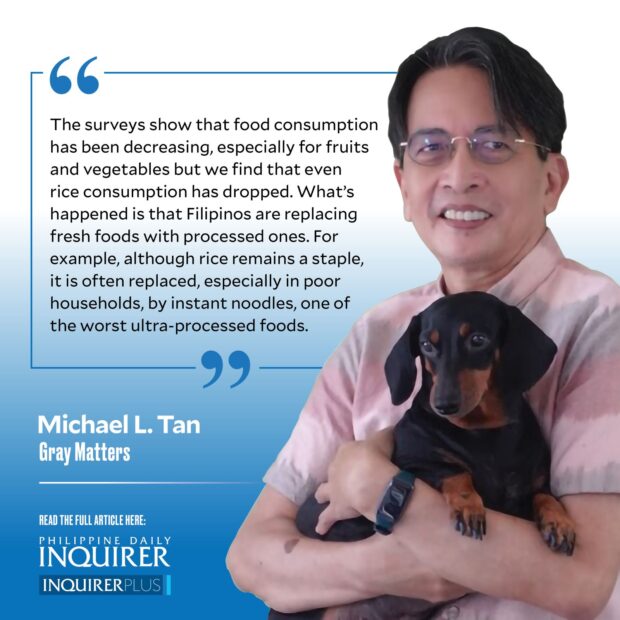Feed the children
 We’re bombarded these days by messages to eat healthy. Restaurants advertise themselves as organic, natural, vegetarian, or even vegan, and newspapers are featuring more and more healthy recipes, again many of them veggie or vegan.
We’re bombarded these days by messages to eat healthy. Restaurants advertise themselves as organic, natural, vegetarian, or even vegan, and newspapers are featuring more and more healthy recipes, again many of them veggie or vegan.
But the messages don’t seem to be getting to young people, and especially to children, where the battles are fought against advertising for fast foods, junk foods, ultra-processed foods. I don’t even know why I’m using “foods,” with food activist (yes, there are food activists now and I hope they don’t get Red-tagged) and writer Michael Pollan preferring the term “edible, food-like substances.”
More than 50 years after our government started doing food consumption surveys and feeding programs, we still have one of the world’s highest rates of stunting, “bansot” in Filipino, with many repercussions from poor performance in schools to difficulties in child delivery and even facing height-based discrimination when applying for jobs.
The surveys show that food consumption has been decreasing, especially for fruits and vegetables but we find that even rice consumption has dropped. What’s happened is that Filipinos are replacing fresh foods with processed ones. For example, although rice remains a staple, it is often replaced, especially in poor households, by instant noodles, one of the worst ultra-processed foods.
There’s nothing wrong with preserved foods—we’ve had them for centuries, from jams and salted items to smoked (tinapa) foods. Canned foods came along only in the 20th century and have a place for an occasional “emergency” meal. Instant noodles, first introduced in 1971, are something else, now found in every corner of the world, with adaptations to local cultures.
The problem with ultra-processed foods is that they are often high in sugar, salt, fats, and oils, all posing health risks. We think of the risks mainly for adults, especially senior citizens, but their effects on children can be tremendous, too—the high salt content affects their kidneys and could induce early high blood pressure. Worst, items like instant noodles become part of a regular diet—even Americans still remember … and crave … instant ramen noodles, which had become part of their college diets.
For poor countries like the Philippines, malnutrition takes two forms: undernutrition and obesity, and of the two, when you think of long-term consequences, it’s the latter that’s more dangerous. We are already seeing a rise in the incidence, even deaths, from cardiovascular diseases and diabetes, even in young adults.
The problems are global and the European community has called for responding to growing childhood malnutrition. Western European countries used to be noted for their social welfare programs: state-subsidized housing, health care, and education, with education including meals in schools. Many of these European countries reduced the subsidies or even got rid completely of subsidized meals but now several are bringing them back, even offering free lunches. The aim is to provide at least one healthy meal each day for the schoolchildren although some of the more progressive countries, for example, Estonia, provide dinner for kids of parents who work late.
It has not been easy for the European countries because the kids’ diets have been wrecked at home, many growing up on fast foods and junk snacks. Even the countries famous for their healthy Mediterranean diets are now having to promote traditional diets in schools. In Spain, school kitchens are encouraged to use fish heads and ham bones to prepare healthier soup stocks, instead of using bouillon cubes (or, for the Philippines, magic this and magic that packets).
Unless we get schools to serve healthy meals, and to introduce food education, the nutritional status of today’s children will continue to go downhill and eventually, society will foot the bills for all its adverse effects. Worst, we find a terrible cultural revolution unfolding, with young people having no memories, or a desire, for traditional healthy foods.
Ideally, it has to be a school cafeteria that brings about the changes. Give priority to concessionaires serving healthy foods. You don’t need gourmet food here. I’m glad to report, to our University of the Philippines alumni, that some of your favorites from your college days—lumpia, turron, saba—are still being sold by the manininda or vendors, and still at very affordable prices although we do have students who have so little money they need to get subsidized meals. (Our varsity athletes also get these subsidized meals, and that went a long way to get us our championships.)
Schools need full-time nutritionists who can provide independent and scientific information and not succumb to the temptations of companies producing food-like substances. Let’s not forget soft drinks and caffeinated beverages, which, I’ve found, are used as breakfasts, without any food.
Yesterday was World Food Day; we need to do our part toward promoting healthier foods for a healthier planet.
—————-
mtan@inquirer.com.ph




















